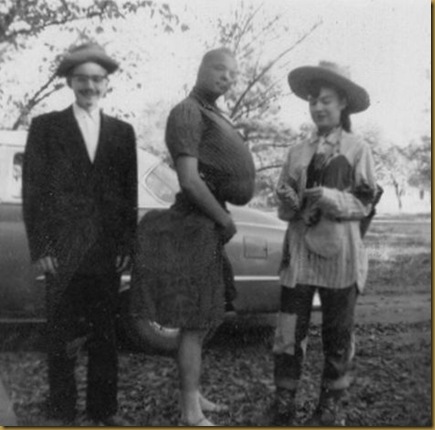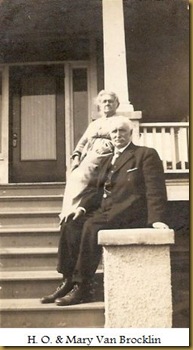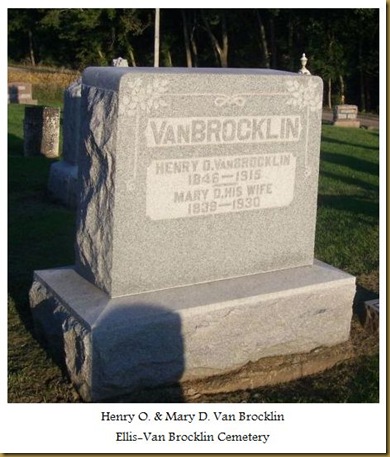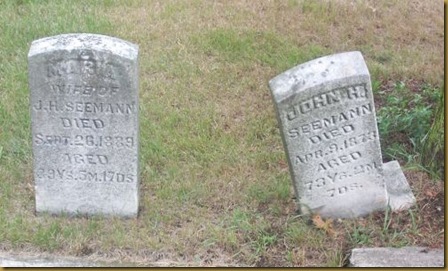

Wednesday, March 30, 2011
Genealogy Societies – The Good, The Bad, and The Ugly
I don’t know about most people, but I have a limited amount of money to spend on society memberships, so I’m constantly having to evaluate benefit vs. cost. I’d love to join many more, but I need to be selective.
I recently discovered the website for an historical society in an area of genealogical interest – close enough geographically that I could utilize their library and even attend meetings from time to time. I liked that their website had a detailed listing of resources. They had a current events widget. Looked great – I just needed to know about their membership fees, journals published, publications for sale, benefits for members, etc. But none of this information was on their website.
They did have a link to email them, which I did. I received an automated reply stating that if I didn’t hear from anyone in 2 weeks, to call them. Really??
I checked their blog, hoping for more information, but it had only one entry and had not been updated in 7 weeks, except by spammers publishing links to questionable websites. Apparently no one at the society reads the comments of their visitors, legitimate or not. It was a disappointment, and needless to say, that particular society has been crossed off my list for membership. The porch light appears to be on, but nobody’s home.
This experience got me thinking about what I, as both a potential new member and a former society volunteer, value in a genealogical or historical society.
1) I love to see an informative, attractive, easily navigated website. Especially one that’s kept up-to-date with current happenings – it shows me that the society is alive and well. Things are happening there.
2) Current members should have easy online access to the information they need. Potential new members should be given good reasons to join – membership fees and benefits are important; contact information and queries that are attended to promptly is imperative. Show me why joining your society would be a great decision. If I didn’t already have an interest, I wouldn’t be at your website.
3) Societies should publish the best journal possible, and publish it regularly. I appreciate getting what I paid for.
4) On a society’s website, I enjoy a short narrative on the history of the area, or some articles on historical local topics – I want to see how interested and excited a society is about their mission. An anemic society isn’t going to excite potential or existing members much either.
5) Are there volunteer opportunities – proofreading, formatting, transcribing, etc. - that can be done from a distance. I’d like to get involved despite the fact that I don’t live in the area. Is there some way that I can help you help us?
6) I love indexes! I’m elated to find an index with an easy way to get the original. For a small fee, payable quickly and easily by PayPal, the society will print and mail a photocopy of the record I need. I can order it, and get it in the mail a few days later. Awesome! And very forward-thinking!
7) A big bonus is a “Members Only” section of the website, where I can access selected library materials or search more detailed indexes. What a boon to members who live a great distance away, and a great reason to join the society, even if I can’t get to the research library in person.
These are just a handful of things that are most important to me. How do *you* feel about it?
I recently discovered the website for an historical society in an area of genealogical interest – close enough geographically that I could utilize their library and even attend meetings from time to time. I liked that their website had a detailed listing of resources. They had a current events widget. Looked great – I just needed to know about their membership fees, journals published, publications for sale, benefits for members, etc. But none of this information was on their website.
They did have a link to email them, which I did. I received an automated reply stating that if I didn’t hear from anyone in 2 weeks, to call them. Really??
I checked their blog, hoping for more information, but it had only one entry and had not been updated in 7 weeks, except by spammers publishing links to questionable websites. Apparently no one at the society reads the comments of their visitors, legitimate or not. It was a disappointment, and needless to say, that particular society has been crossed off my list for membership. The porch light appears to be on, but nobody’s home.
This experience got me thinking about what I, as both a potential new member and a former society volunteer, value in a genealogical or historical society.
1) I love to see an informative, attractive, easily navigated website. Especially one that’s kept up-to-date with current happenings – it shows me that the society is alive and well. Things are happening there.
2) Current members should have easy online access to the information they need. Potential new members should be given good reasons to join – membership fees and benefits are important; contact information and queries that are attended to promptly is imperative. Show me why joining your society would be a great decision. If I didn’t already have an interest, I wouldn’t be at your website.
3) Societies should publish the best journal possible, and publish it regularly. I appreciate getting what I paid for.
4) On a society’s website, I enjoy a short narrative on the history of the area, or some articles on historical local topics – I want to see how interested and excited a society is about their mission. An anemic society isn’t going to excite potential or existing members much either.
5) Are there volunteer opportunities – proofreading, formatting, transcribing, etc. - that can be done from a distance. I’d like to get involved despite the fact that I don’t live in the area. Is there some way that I can help you help us?
6) I love indexes! I’m elated to find an index with an easy way to get the original. For a small fee, payable quickly and easily by PayPal, the society will print and mail a photocopy of the record I need. I can order it, and get it in the mail a few days later. Awesome! And very forward-thinking!
7) A big bonus is a “Members Only” section of the website, where I can access selected library materials or search more detailed indexes. What a boon to members who live a great distance away, and a great reason to join the society, even if I can’t get to the research library in person.
These are just a handful of things that are most important to me. How do *you* feel about it?
Friday, March 25, 2011
Forebear Friday - Marrying the Enemy? Thomas Nickerson & Mary Bangs
Perhaps it was a bit of a Romeo and Juliet story. But at the least it might have made for some interesting family reunions. The union of Thomas Nickerson and Mary Bangs (my 8th great-grandparents) in 1696 had the potential to cause quite a stir among their families. Thomas was the grandson of immigrant William Nickerson, and Mary was the granddaughter of Plymouth colonist Edward Bangs.
The problem goes back to land, and their grandfathers. As a member of Plymouth colony, Edward Bangs was among those who had the first rights, given by the Court, for purchasing reserved land from the Indians. William Nickerson, who sought to acquire land and create a settlement, purchased a great deal of this reserved land himself, illegally, a move said to have greatly angered the colonists. Nickerson claimed ignorance of the law, and the matter was in court for many years. While the land was granted to others, Nickerson eventually re-purchased much of it from the grantees, and so started the settlement of Monomoit (Chatham, Massachusetts) as he wished.
I wonder what the reaction of Edward Bangs and William Nickerson might have been to their grandchildren marrying, had they lived to see it...
Friday, March 18, 2011
Forebear Friday – Henry O. Van Brocklin
Stephenson county, Illinois was in Henry Orville Van Brocklin’s blood. The last child of Florence township pioneers Conrad and Harriet (Searle) Van Brocklin, he was born on 24 Feb 1846 in Freeport.

As a young man, he taught several terms of school, and joined his father in farming the 375 acre home farm. And like his father before him, he held Florence township offices. He took over the farm entirely when his father died in 1877.
He married Mary D. Woolheiser, daughter of Emanuel and Amanda (Crosby) Woolheiser, a native of New York, in 1871. They had five children – a son and a daughter who died in infancy; Inez (born 1875); Iva (b. 1879); and Arthur (born 1881). Inez married Horatio Stevens; Arthur married Mabel Rampenthal; and Iva married Ellis Goodsell, and their sons Wilber and Lowell appear to have ownership of the farm in the late 1950s.
Henry Orville Van Brocklin left this world in the same place he entered it – the city of Freeport – on 6 December 1915, at the age of 69. His wife died some 30 years later. Like so many others of Henry’s family, they was buried in Ellis-Van Brocklin cemetery, immediately across the creek from the family farm.


As a young man, he taught several terms of school, and joined his father in farming the 375 acre home farm. And like his father before him, he held Florence township offices. He took over the farm entirely when his father died in 1877.
He married Mary D. Woolheiser, daughter of Emanuel and Amanda (Crosby) Woolheiser, a native of New York, in 1871. They had five children – a son and a daughter who died in infancy; Inez (born 1875); Iva (b. 1879); and Arthur (born 1881). Inez married Horatio Stevens; Arthur married Mabel Rampenthal; and Iva married Ellis Goodsell, and their sons Wilber and Lowell appear to have ownership of the farm in the late 1950s.
Henry Orville Van Brocklin left this world in the same place he entered it – the city of Freeport – on 6 December 1915, at the age of 69. His wife died some 30 years later. Like so many others of Henry’s family, they was buried in Ellis-Van Brocklin cemetery, immediately across the creek from the family farm.

Sources:
Van Brocklin, H. O. & Mary (Woolheiser). Photograph. ca. 1910. Digital image. Privately held by Christine Martin [address for private use]. 2008.
Van Brocklin, H. O. & Mary (Woolheiser) headstone. Photograph, Ellis-Van Brocklin cemetery, Section 17, Florence township, Stephenson county, Illinois. Digital image. Privately held by Gary and Karen Seeman [address for private use]. 2006.
Portrait & Biographical Album of Stephenson County, Illinois. Chicago: Chapman Brothers. 1888
Friday, March 11, 2011
Forebear Friday – John Q. Adams

John Quincy Adams had a successful and adventurous life, but then, his family had already established a culture of adventure. His great- grandfather was a founder of St. Johnsbury, Vermont, he and wife Submit being the first settlers. John’s grandfather, Martin Adams with his brother, were among the founders of Newport (then Duncansborough), Vermont, and Martin was a Revolutionary War patriot.
John Q., the son of Abial Adams and Irene Gray, was born 12 Jul 1831 in Newport, Vermont, the sixth of sixteen children. At the age of 16, he moved himself to Burlington, Vermont, to attend college, supporting himself and paying tuition by teaching school. He did this for two years, and then returned to the house of his father. The following year, in 1851, he made his way to Stephenson County, Illinois, and decided to try his luck in the California Gold Rush, heading west in 1853. He spent five years there, after which he returned to Stephenson county with $1,000 and purchased a 240 acre farm in Florence township. He married Julia Van Brocklin, daughter of Florence township pioneers Conrad and Harriet Van Brocklin. About 1900, he was engaged as a store keeper, but otherwise farmed and worked as a carpenter.
He sold his farm in 1901, and relocated to Sutherland, O’Brien County, Iowa. His wife died in 1905, and he in 1907. They were both buried at Waterman Cemetery, just outside of Sutherland.
Thursday, March 10, 2011
Adventures in Gardena
While transcribing old letters written by my great-grandparents, Peter C. and Ella Christensen, I came across the following story, related by Pete to their daughter Lillian in a letter dated Dec. 20, 1946. Pete and Ella had just moved to Gardena, California from Huron, South Dakota, where their daughter and her family still lived.
“I suppose Mother told you about our bad luck with the car, but I know she really didn’t know how it happened so I’ll tell you, ha ha. We went out to Silver Lake, that is where my sister Katrine is living. We stayed there all night as we didn’t have our gas and electricity turned on. So in the morning we went out to our car, it was parked on a hillside, almost a mountain. The brake alone would stop it from going down hill so I left it in low gear. You know it was foggy in the evening so the windshield was clouded over. I got a rag and started to clean it off. Mother climbed in the car. And first thing I knew the car started down hill, very slowly at first. She tried to get out but was afraid to let go of the car. There she was half out and half in, and I had to pull hard on her to make her let go. It’s a wonder she did not get hurt. You know when she got in the car she pushed the lever with her legs and got it out of gear. Next time I’m going to leave it in reverse. The car went across the street and dropped about 10 ft then over another garage and a drop almost straight down of about 20 ft and landed up against a house. It made a big dent in the wall of the house. I’m glad it was not a brick wall. The car never even turned over. A Ford can really take it. Estimated damage to car $180.00 The man who owns the house claims damage to house and lot $3000. A darn good thing I had insurance, don’t you think? It cost $25 to get the car hoisted up to the street again with a crane and 2 trucks. I was able to run the car after it was pulled up. It had one crumpled fender, two damaged running boards, 3 broken windows, broken grill and bent bumper. I’m sure it could never do that again, and be able to run.”
He went on to describe “city driving”:
“You should try to drive a car in San Diego or Los Angeles. They pass you on both sides and if you have to make a right or left turn, and aren’t in the right place it’s just too bad. They are smashing cars every day. I don’t want a new car for awhile. “
“I suppose Mother told you about our bad luck with the car, but I know she really didn’t know how it happened so I’ll tell you, ha ha. We went out to Silver Lake, that is where my sister Katrine is living. We stayed there all night as we didn’t have our gas and electricity turned on. So in the morning we went out to our car, it was parked on a hillside, almost a mountain. The brake alone would stop it from going down hill so I left it in low gear. You know it was foggy in the evening so the windshield was clouded over. I got a rag and started to clean it off. Mother climbed in the car. And first thing I knew the car started down hill, very slowly at first. She tried to get out but was afraid to let go of the car. There she was half out and half in, and I had to pull hard on her to make her let go. It’s a wonder she did not get hurt. You know when she got in the car she pushed the lever with her legs and got it out of gear. Next time I’m going to leave it in reverse. The car went across the street and dropped about 10 ft then over another garage and a drop almost straight down of about 20 ft and landed up against a house. It made a big dent in the wall of the house. I’m glad it was not a brick wall. The car never even turned over. A Ford can really take it. Estimated damage to car $180.00 The man who owns the house claims damage to house and lot $3000. A darn good thing I had insurance, don’t you think? It cost $25 to get the car hoisted up to the street again with a crane and 2 trucks. I was able to run the car after it was pulled up. It had one crumpled fender, two damaged running boards, 3 broken windows, broken grill and bent bumper. I’m sure it could never do that again, and be able to run.”
He went on to describe “city driving”:
“You should try to drive a car in San Diego or Los Angeles. They pass you on both sides and if you have to make a right or left turn, and aren’t in the right place it’s just too bad. They are smashing cars every day. I don’t want a new car for awhile. “
Friday, March 4, 2011
Forebear Friday - John Henry Seemann
John Henry Seemann was born in 1800 in Schleswig-Holstein, Germany, the son of Hans Seemann and Christina Petersen Moldt. He married Maria, and they were the parents of 8 children.
In 1853, sons Hans and Detlef left Germany for the United States, in particular, eastern Iowa. The following year, John and Mary boarded with Germania, traveling from Bremen to New York, with sons Johan and Henry. Most, if not all, of their children ended up coming to Iowa. John and Maria purchased land in Jackson county, Iowa later that year, but by 1856 had moved in with their son Hans in Clinton county, just to the south. By 1870, they were back in Jackson county, this time with their son Henry and his family.
John died on 09 April 1873, and Maria went back to Clinton county to son Hans’ home; however, in 1884, Hans’ family sold the farm and moved to South Dakota, and Maria apparently went back to Jackson County, where she died on 26 Sep 1889.
On a trip to this area a few years back, we decided to visit Evergreen cemetery in Jackson County. It’s a beautiful cemetery located next to the backwaters of the Mississippi River, and true to its name, lots of fragrant evergreens dot the landscape. We located the graves of John and Maria, in a family section which included the graves of their son Henry, Henry’s wife Catharina; their daughter Mary Blossfeld and her husband William and daughter Lotta. In another part of the cemetery, John and Maria’s son Peter is buried.

In 1853, sons Hans and Detlef left Germany for the United States, in particular, eastern Iowa. The following year, John and Mary boarded with Germania, traveling from Bremen to New York, with sons Johan and Henry. Most, if not all, of their children ended up coming to Iowa. John and Maria purchased land in Jackson county, Iowa later that year, but by 1856 had moved in with their son Hans in Clinton county, just to the south. By 1870, they were back in Jackson county, this time with their son Henry and his family.
John died on 09 April 1873, and Maria went back to Clinton county to son Hans’ home; however, in 1884, Hans’ family sold the farm and moved to South Dakota, and Maria apparently went back to Jackson County, where she died on 26 Sep 1889.
On a trip to this area a few years back, we decided to visit Evergreen cemetery in Jackson County. It’s a beautiful cemetery located next to the backwaters of the Mississippi River, and true to its name, lots of fragrant evergreens dot the landscape. We located the graves of John and Maria, in a family section which included the graves of their son Henry, Henry’s wife Catharina; their daughter Mary Blossfeld and her husband William and daughter Lotta. In another part of the cemetery, John and Maria’s son Peter is buried.

Subscribe to:
Posts (Atom)